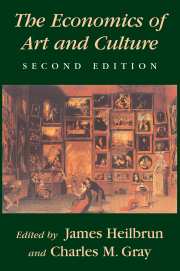Book contents
- Frontmatter
- Contents
- List of figures and tables
- Preface
- Part I The arts sector: Size, growth, and audiences
- 1 An overview of the arts sector
- 2 Growth of the arts sector
- 3 Audiences for the arts
- Part II The microeconomics of demand and supply
- Part III The fine arts and museums
- Part IV Public policy toward the arts
- Part V Art, economy, and society
- Index
1 - An overview of the arts sector
Published online by Cambridge University Press: 05 September 2012
- Frontmatter
- Contents
- List of figures and tables
- Preface
- Part I The arts sector: Size, growth, and audiences
- 1 An overview of the arts sector
- 2 Growth of the arts sector
- 3 Audiences for the arts
- Part II The microeconomics of demand and supply
- Part III The fine arts and museums
- Part IV Public policy toward the arts
- Part V Art, economy, and society
- Index
Summary
In the modern era, the making of art has occupied a special position among human activities. Some might rank it as the highest of all callings; many probably think of it as above “mere commerce”; a few might wish that economists would keep their dirty hands off it.
Yet no matter how highly we may value them, art and culture are produced by individuals and institutions working within the general economy, and therefore cannot escape the constraints of that material world. When the Guthrie Theater in Minneapolis hires actors or electricians, it competes in well-defined labor markets and has to pay what the market, or the unions, require. When it sets ticket prices it has to recognize that its sales will be constrained by competition from other forms of recreation and by the tastes and incomes of its potential audience. When federal or state governments, through their arts agencies, make grants to the Guthrie, those agencies have received their funds through a budgetary process in competition with other government programs, and the government itself raises money by making claims on taxpayers that compete with their desire to spend income in the satisfaction of private wants.
In keeping with its title, The Economics of Art and Culture, this book explains how art and culture function within the general economy. In many respects the individuals and firms that consume or produce art behave like consumers and producers of other goods and services; in some significant ways, however, they behave differently.
- Type
- Chapter
- Information
- The Economics of Art and Culture , pp. 3 - 10Publisher: Cambridge University PressPrint publication year: 2001



